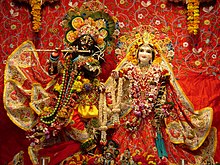Ashtami
Ashtami (अष्टमी aṣṭamī) is the eighth day (Tithi) of Hindu lunar calendar.[1]
Festivals
[edit]Krishna Janmashtami
[edit]Krishna Janmashtami or Gokul Ashtami is a Hindu festival celebrating the birth of Lord Krishna, an avatar of Hindu deity Vishnu.[2]
Krishna Janmashtami is observed on the Ashtami tithi, the eighth day of the dark half or Krishna Paksha of the month of Bhaadra in the Hindu calendar, when the Rohini Nakshatra is ascendant. Rasa lila or dramatic enactments of the life of Krishna are a special feature in regions of Mathura, and Vrindavan, Nalbari and regions following Vaishnavism in Manipur.[3]
Radhashtami
[edit]
Radhashtami or Radha Jayanti is the Hindu festival celebrating the appearance day of Goddess Radha, avatar of Lakshmi. The festival is celebrated annually on the eighth day of Bhadra month of bright moon. On this day, devotees keep fast, sing glories, dance and enact the divine pastimes of Goddess Radha.[4]
Trilochan Ashtami
[edit]
Trilochana Ashtami or Trilochanashtami (त्रिलोचन अष्टमी), is a Hindu auspicious day dedicated to Lord Shiva and Goddess Parvati celebrated in Odisha and different parts of India.[5]
Tri(त्रि) means Three and lochan(लोचन) means Eye. Hence one who having three eyes is called as Trilochan (त्रिलोचन) literally means to Shiva, three-eyed, that is, indication of the present, past and future.[6]
Bhairava Ashtami
[edit]Bhairava Ashtami or Kalabhairava Ashtami commemorating the day Kal Bhairav, a fierce manifestation of Shiva, appeared on earth, is celebrated on Krishna paksha Ashtami of the Margashirsha month with a day special prayers and rituals.[7]
Sheetala Ashtami
[edit]Sheetala Ashtami is dedicated to the goddess Shitala or Sheetala.
References
[edit]- ^ Ashtami The eighth day of the Navaratra
- ^ Srinivasan (12 July 2011). Hinduism For Dummies. Krishna Janmashtami. John Wiley & Sons. pp. 241–. ISBN 978-0-470-87858-3. Retrieved 19 May 2012.
- ^ Ernst Wilhelm. Classical Muhurta. Ashtami. Kala Occult Publishers. pp. 36–. ISBN 978-0-9709636-2-8. Retrieved 19 May 2012.
- ^ LLP, Adarsh Mobile Applications. "Bhadrapada Month festivals in Hindu Calendar". Drikpanchang. Retrieved 2022-03-30.
- ^ "Hindu Dharma Festivals". Archived from the original on 2012-05-20. Retrieved 2012-05-19.
- ^ Kamal Prashad Sharma (1 August 2001). Maṇimahesh Chambā Kailāsh. Trilochanashtami (त्रिलोचन अष्टमी). Indus Publishing. pp. 135–. ISBN 978-81-7387-118-4. Retrieved 19 May 2012.
- ^ Dr. Bhojraj Dwivedi (2006). Religious Basis Of Hindu Beliefs. Diamond Pocket Books (P) Ltd. p. 172. ISBN 8128812394.
